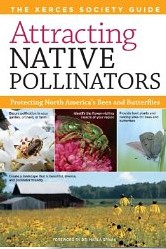 As gardeners we appreciate the value of pollinators. Without them we would not have many of the flowers, vegetables, and fruits that we enjoy in our gardens and on our tables. In fact, about seventy five percent of flowering plants depend on pollinators in order to produce seed or fruit so it behooves all gardeners to ensure that pollinators are protected and encouraged. The Xerces Society’s book, Attracting Native Pollinators, it a giant step forward in the identification, understanding, and protection of pollinators.
As gardeners we appreciate the value of pollinators. Without them we would not have many of the flowers, vegetables, and fruits that we enjoy in our gardens and on our tables. In fact, about seventy five percent of flowering plants depend on pollinators in order to produce seed or fruit so it behooves all gardeners to ensure that pollinators are protected and encouraged. The Xerces Society’s book, Attracting Native Pollinators, it a giant step forward in the identification, understanding, and protection of pollinators.
The aim of Attracting Native Pollinators is to provide a comprehensive guide for habitat management to benefit pollinating insects. It focuses on native bees but includes material on other invertebrate pollinators such as wasps, butterflies, moths, beetles, and flys. After discussing the biology of pollination, the life cycle and different kinds of pollinators, and the threats faced by pollinators, the book turns to a consideration of strategies to increase both the abundance and variety of pollinators . These strategies involve creating habitats that have four major features in common: a diversity of plants, nesting and egg-laying sites with nesting material, sheltered and undisturbed places for hibernation and overwintering, and freedom from poisonous chemicals. Detailed discussions provide specific information on such topics as providing foraging habitat with a focus on native plants, reducing the impact of land management practices on pollinators, and how farmers, home owners, schools, and community officials can contribute to the overall effort. Regional plant lists provide information on native herbaceous plants, trees and shrubs and sample garden plans suggest ways of incorporating them into the landscape. One of the most outstanding section in the book the one devoted to the identification and description of over 30 different species of native bee. Did you know that there are over fifty different kinds of bumble bee in North America? Or that male digger bees fall asleep holding onto a plant with their jaws? This section of the book tells you not only indentifying characteristics of each kind of bee, but also about its foraging and nesting habits and associated conservation concerns. A close up photograph of each kind of bee allows the reader to appreciate to differences between them.
If you are interested in habit improvement to benefit pollinators, especially native bees, this is the book to buy. Written by staff of the Xerces Society, an international nonprofit organization prominent in pollinator conservation, this book gives you everything you need to help increase the dwindling numbers of pollinators. The style of writing is formal, clear, and easy to understand; the photographs are detailed and visually pleasing. A great resource and addition to the reference section of a home library.